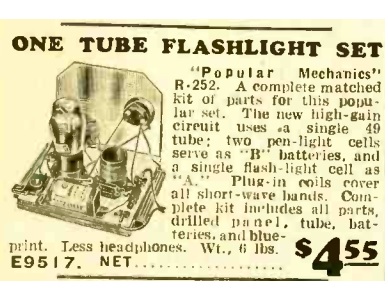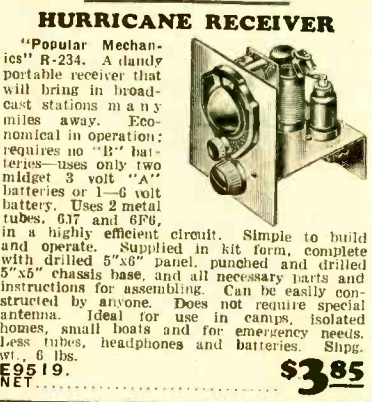75 years ago, the 1939 Allied Radio catalog carried these two kits. The “One Tube Flashlight Set” sold for $4.45, and included everything (tube, batteries, and coils) with the exception of the headphones, which started in the same catalog for 66 cents. The “Hurricane Receiver” sold for $3.85, but in addition to the headphones, also required a 6J7 and a 6F6 tube, which sold for 77 cents each.
Both sets ran on 6 volts. The one-tube “flashlight” set tuned shortwave, 18 to 200 meters, with four plug-in coils.
Both of these sets are regenerative receivers, and originated as construction articles in Popular Mechanics. The “Flashlight” set originated in the April 1938 issue, where it was billed as a “one-tube DX short-wave set” that ran on flashlight batteries, hence the name.
The “hurricane set” was featured in the February 1937 issue, which stated:
The primary idea behind the design is to provide a simple, rugged portable receiver that will work from a 6-volt storage battery, or a few dry cells, when other sources of power fail. When floods, hurricanes or other natural catastrophes occur and all ordinary means of communication go out, it is satisfying, and sometimes vitally important, to be able to learn from outside radio stations just what is going on. As a portable knockabout set, it also has other useful applications in the home, boat or camp.
The article promises that with six volts, the hurricane set with a 25-foot antenna should be sufficient for satisfactory reception of medium or high-power stations within a range of about 500 miles.
Parts List for “Flashlight Set”
If you are interested in building a one-tube radio, the “flashlight set” would be a good starter, and you can use the Popular Mechanics article for all of the construction details. Some of the parts might be difficult to find. But all of them are available online. Some of the links below are rather expensive, so it’s best to find most of the parts locally. But if you’re missing one or two items, you can find them at the links below.
Some of the values shown here are not identical to those shown in the article, but all of them are close enough. The only effect of substituting parts is that the tuning range of the radio will vary, depending on the exact dimensions of the coil, and the value of the tuning capacitor. Therefore, you’ll have to experiment a bit to figure out the exact tuning range of the radio once it’s done.
- Plug-in coil form
- Coil socket
- 30 ga. enameled wire
- 26 ga. enameled wire
- 0-30 pF trimmer capacitor
- .00014 uF (140 pF) variable capacitor
- 2 megohm resistor
- .0001 uF (10 pF) capacitor
- .0005 uF (50 pF) capacitor
- 200 kilohm variable resistor with switch
- RF Choke
- Type 49 tube
- Tube socket
- Battery holder for one AA-cell battery
- Battery holder for four AA-cell batteries
- Knobs



Pingback: 1934 Scout’s One Tube Radio | OneTubeRadio.com
Pingback: 1937 Popular Mechanics Hurricane Receiver | OneTubeRadio.com
Pingback: Hurricane Preparations | OneTubeRadio.com